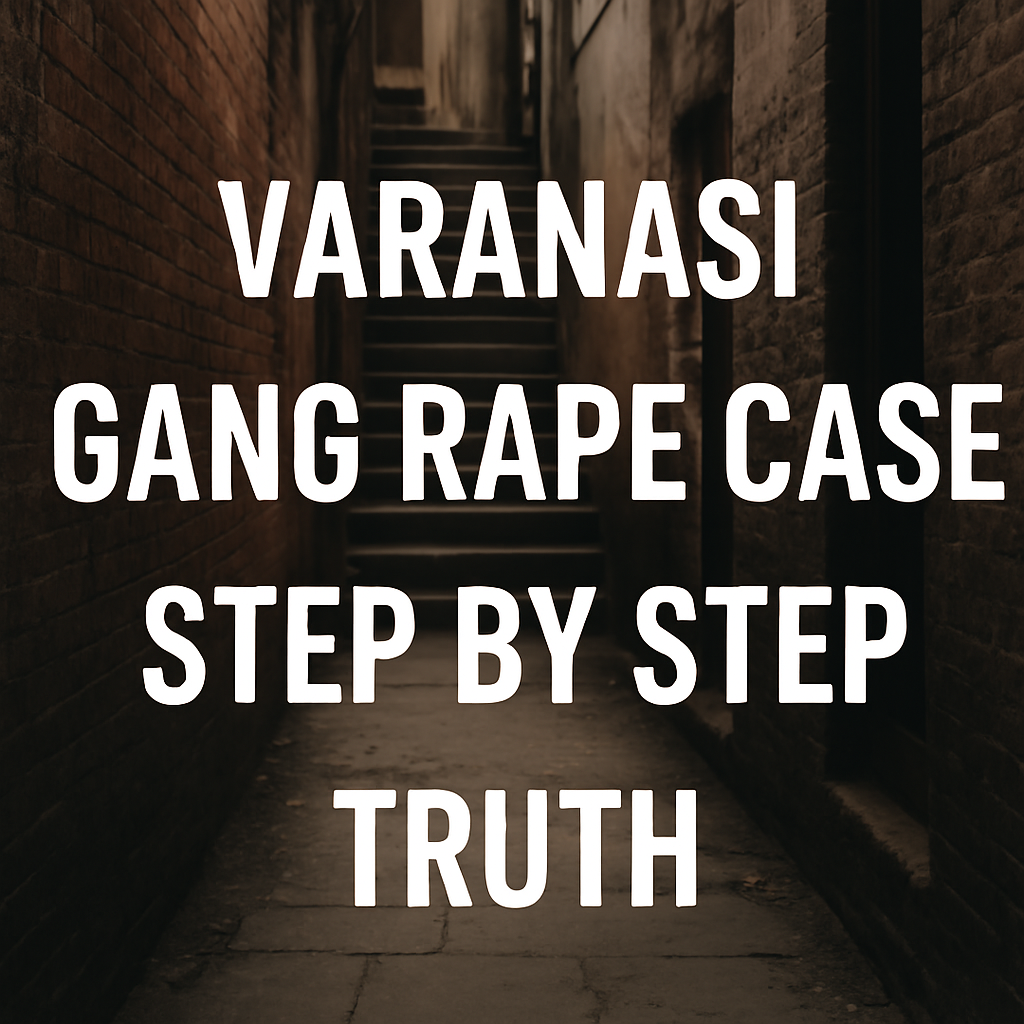Legal Implications of Varanasi Gang Rape Case
The recent Varanasi gang rape case, involving the alleged assault of a 19-year-old woman by 23 individuals over several days, has brought significant attention to the legal framework addressing such heinous crimes in India. Understanding the legal implications requires an examination of the specific laws under which the accused can be prosecuted.The Economic Times
Table of Contents
Applicable Legal Provisions
- Section 376D of the Indian Penal Code (IPC) – Gang Rape:
This section addresses situations where a woman is raped by one or more persons constituting a group. The law mandates rigorous imprisonment of not less than 20 years, which may extend to life imprisonment, along with a fine. The fine is intended to cover the medical expenses and rehabilitation of the victim. - Section 328 IPC – Causing Hurt by Means of Poison, etc., with Intent to Commit an Offense:
Given that the victim was allegedly drugged, this section becomes relevant. It penalizes the act of administering any stupefying substance to cause harm or facilitate the commission of an offense, with imprisonment that may extend to 10 years and a fine. - Section 370 IPC – Trafficking of Persons:
If evidence suggests that the victim was moved or confined against her will for exploitation, this section could be invoked. It prescribes rigorous imprisonment of not less than 7 years, which may extend to 10 years, along with a fine. - Section 120B IPC – Criminal Conspiracy:
If the assault was premeditated and involved coordination among the accused, this section addresses the conspiracy aspect, with punishments corresponding to the severity of the offense conspired. - Section 34 IPC – Acts Done by Several Persons in Furtherance of Common Intention:
This section is pertinent when a criminal act is done by several persons in furtherance of a common intention, making each person liable as if they had done the act alone.

Procedural Aspects and Victim Support
- Medical Examination: Under Section 164A of the Code of Criminal Procedure (CrPC), a prompt medical examination of the victim is crucial for collecting evidence.
- Police Investigation: The police are required to conduct a thorough investigation, including collecting forensic evidence, recording statements, and apprehending all accused individuals.
- Trial Process: Given the gravity of the offense, the case may be tried in a fast-track court to ensure swift justice.
- Victim Compensation: As per Section 357A of the CrPC, the victim is entitled to compensation for rehabilitation, which is provided by the state government.
Varanasi Gang Rape Case Step By Step Truth
Step 1: Victim’s Sudden Silence or Disappearance Raised Suspicion
The first sign often comes from a sudden change in the victim’s routine:
- She may have stopped communicating with friends or family.
- There were likely gaps in her whereabouts or unexplained absences.
- If she was living in a sensitive environment (like in a known area of drug use or exploitation), people around her may have had suspicions.
But due to social fear or pressure, many families or girls stay silent — this is the sad reality.
Step 2: Physical or Mental Signs of Abuse Became Visible
Eventually, someone — a family member, teacher, neighbor, or friend — may have noticed:
- Physical injuries
- Fatigue, withdrawal, or crying fits
- Signs of drug use or unusual behavior
These are the red flags that trigger concern, especially when they repeat.
Step 3: A Medical Emergency or Mental Breakdown
In many such cases:
- The victim might collapse, fall ill, or be brought to a hospital.
- During medical checks, doctors suspect abuse or drugging.
- In Varanasi’s case, reports indicated she was drugged and repeatedly abused — so this may have come to light when she was found unconscious or unwell.
Under Indian law, doctors must report sexual assault suspicions to the police — this is often how the formal process begins.
Step 4: Victim’s Statement or Family’s Complaint
Once the girl is in a safe environment, and someone supports her:
- She may reveal the truth of what happened — how she was drugged, trapped, and assaulted by multiple people.
- Sometimes, if she’s a minor, the family may notice emotional breakdowns and force the conversation.
This is when the family often goes to the police station to file an FIR (First Information Report).
Step 5: FIR Lodged and Initial Police Action
The FIR likely included:
- Charges under IPC Section 376D (gang rape),
- POCSO Act (if she was a minor),
- Section 328 IPC (causing harm by poison or drug),
- And other sections for kidnapping or wrongful confinement.
This made it a serious cognizable offense, demanding immediate police action.
Step 6: Investigation Begins — Spot Visits, Forensics, CCTV
Once police get the complaint, they:
- Visit the crime location
- Collect medical evidence
- Retrieve CCTV footage, phone records, drug samples, and any other proof.
In such gang rape cases, finding digital evidence or eyewitnesses is key.
Step 7: Arrest of Accused
Once evidence matched:
- Police arrested the accused, who reportedly had a history of such behavior.
- In this case, local involvement and influence delayed immediate arrest — showing the failure of local law enforcement and political interference.
Step 8: Media and Public Outrage
Once the case went viral:
- Social media and local news channels picked it up.
- Activists, women’s groups, and opposition leaders raised questions on police silence.
- This pressured authorities to act seriously.
Step 9: Medical Report and Victim Protection
Doctors submitted their forensic report, confirming signs of:
- Drug use
- Sexual assault injuries
- Psychological trauma
The girl was placed under medical and mental health support, and a counselor or NGO worker may have been assigned.
Step 10: Judicial Involvement and Court Orders
Now, the case is under legal proceedings. The High Court or District Judge may:
- Order a fast-track trial
- Involve state child protection units
- Ask police for regular reports

⚠️ Why This Matters
The Varanasi case was not recognized early — the girl had reportedly faced threats, abuse, and drugs, but the system failed to catch early signs.
- No early FIR.
- No community protection.
- And lack of police urgency enabled the crime to continue.
Why Are Indian Laws Not Stringent Enough for Heinous Crimes?
We often ask – how do such brutal crimes still happen despite having laws? The truth is, India does have laws in place to deal with heinous crimes like rape, murder, trafficking, etc. But the problem lies not just in the law itself, but in how it is implemented, monitored, and enforced.
Let’s break this down.
🧷 1. Laws Are There, But Delayed Justice Kills the Purpose
One of the biggest weaknesses is that justice takes too long. A rape or murder case might take 5-10 years to reach a conclusion. By then, evidence weakens, the victim loses hope, and the public forgets. That delay sends a message that criminals can get away or stretch the system long enough to escape harsh punishment.
🧷 2. Police Action Is Often Slow or Biased
In many cases (like the Varanasi gang rape), the police are either careless or pressured. Victims are not taken seriously at first, FIRs are delayed, and sometimes even victim-blaming happens. This gives the accused time to escape, destroy evidence, or even threaten the survivor.
🧷 3. Loopholes in the Law Help the Accused
Our laws often come with bail options, “good behavior” clauses, and multiple layers of appeal. This might work for general legal safety, but in heinous crimes, it becomes a loophole. The accused may get interim bail or walk out on technical grounds, making victims feel unsafe and powerless.
🧷 4. Lack of Fear Due to Low Conviction Rates
In India, the conviction rate for rape cases is under 30%. That means 7 out of 10 accused may actually go free. Why? Poor investigation, tampered evidence, witness threats, and weak chargesheets.
When criminals see that most people go unpunished, they don’t fear the law.
🧷 5. Society’s Silence and Victim Shaming
Unfortunately, many victims (especially women) are scared to speak up because society often questions their character. If people around don’t support the survivor, the system becomes even harder to fight. And when crimes go unreported, the law never even gets the chance to work.
🧷 6. Lack of Fast-Track Courts and Special Units
We need more fast-track courts and trained officers to handle sensitive crimes. Right now, regular courts are overloaded, and there are not enough rape crisis centers or counselors in every district. This adds more delay and trauma for the victim.
🧷 So, Why Did the Varanasi Case Happen So Easily?
- The system failed to protect the girl after the first sign of danger.
- If she was drugged, how did the accused get access to her repeatedly without being noticed?
- No quick FIR, no preventive action, no fear of law – gave the criminals confidence.
That’s the brutal reality.
The state system’s involvement in the Varanasi case is not just about who committed the crime — it’s about how the entire government machinery failed at multiple levels, knowingly or unknowingly, and indirectly enabled the crime to happen.
1. Police Inaction or Delayed Action
The first and most visible failure is the role of the local police:
- No immediate FIR was registered when the first signs of danger emerged.
- If there were prior complaints (like stalking, threats, or missing reports), they were either ignored or not acted upon seriously.
- In many such cases, police discourage victims from pursuing cases due to “social reputation” or personal bias.
- The police often blame the victim by labeling it as a “relationship gone wrong” or a “family matter,” instead of acting on facts and evidence.
This delay or casual attitude from police emboldens criminals. When police do not act promptly, they lose control of the situation, and in many cases, evidence is lost forever.
🔴 2. Weak Preventive Mechanisms by State Authorities
There are no effective tracking or monitoring systems for:
- Repeat offenders
- Individuals with a criminal background
- Cases of missing women or repeated threats
The state government machinery — including departments of women’s welfare, education, and child protection — often work in isolation, without a central response unit to address high-risk or vulnerable individuals.
If a girl has tried to run away before (as rumored in this case), there should have been a counseling session, social investigation, or some form of state-led intervention — but that never happened.
🔴 3. Failure of State Legal Aid and Awareness Programs
The state is responsible for ensuring every citizen:
- Knows their rights
- Knows how to report crimes
- Can access free legal aid if they are vulnerable
In reality, most people (especially young women) don’t know:
- How to file an FIR properly
- What to do in case of blackmail or drugging
- Where to go for fast legal help
This means the state’s awareness programs are either not reaching the right people, or not taken seriously by the public. That’s a clear governance failure.
🔴 4. Negligence by Women Safety Cells & Helplines
U.P. and other Indian states have dedicated helplines like:
- 1090 (Women Power Line in UP)
- Women safety desks in police stations
- Women helpline 181
But how many people know these numbers? How many times have these helplines been tested or audited for actual response time?
If these platforms existed and weren’t responsive, then the state failed in providing real-time protection to this girl. If no one picked up, followed up, or helped — then what’s the point of having such services?
🔴 5. Failure in School & Community Reporting Systems
If the girl was in school or college, the school authorities could have been a support system — if they had the training and responsibility to do so.
However, India has no proper community-based reporting system for:
- Mental distress
- Suspected abuse or blackmail
- Peer bullying or exploitation
The state education department should have made sure that every girl has someone trusted to talk to, especially if she is facing any kind of trauma. But the ground reality is far from ideal.
🔴 6. No Fast-Track Monitoring or Women Safety Task Force
After the 2012 Nirbhaya case, many states promised:
- Women’s safety task forces
- Fast-track courts
- CCTV networks
- Streetlight programs in sensitive areas
But in small towns like Varanasi, these systems are either missing or inactive.
Even today, there is no central body within the district police or state government that keeps track of ongoing women safety cases in real-time, making prevention nearly impossible.
🔴 7. Failure in Post-Crime Handling: Leaking Names, Delayed Medical Help
In many cases like this:
- The victim’s identity is leaked to the media or social media
- Police delay sending her for medical examination
- No proper psychological help is provided
- Family is pressured not to pursue the case strongly
This shows how even after the crime, the state fails to treat the victim and her family with dignity, adding to their trauma.
✅ Crime Happened Because the State System Didn’t Do Its Job
This was not just a crime by a few individuals — it was the result of:
- Police laziness or bias
- No proactive intervention by child or women welfare officers
- Zero follow-up on earlier warning signs
- No support system for the victim
- Total lack of fear in the minds of the criminals
The state did not pull the trigger — but it left the gun loaded and unlocked.
✅ What Can Be Done Now?
- Stronger & specific punishment laws for gang rape and repeated offenders.
- 100% fast-track courts with judgments in under 6 months.
- Mandatory CCTV, check-ins, tracking in sensitive zones.
- Protect survivors, not silence them.
- Public accountability for police and local officials who fail to act.
Until the system becomes faster, fearless, and victim-friendly, these crimes will continue to happen — even with laws written on paper.
Conclusion Varanasi Gang Rape Case Step By Step Truth
The Varanasi gang rape case underscores the importance of stringent legal provisions and their effective implementation to address and deter such crimes. The Indian legal system provides a comprehensive framework to prosecute the accused and support the victim, but the efficacy of these measures depends on prompt and diligent action by law enforcement and judicial authorities.
For more detailed information on India’s rape laws, you can refer to resources such as Nyaaya

